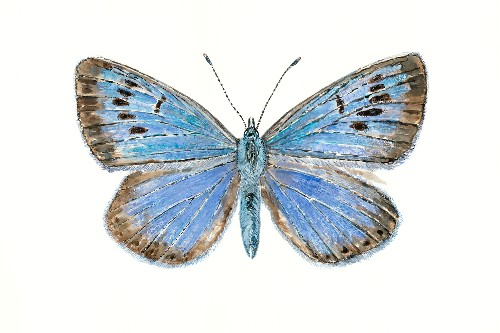University of Bristol Celebrates Regenerated Large Blue Butterfly with Film Screenings
Bristol is a city famous for its blue glass, but the beautiful Large Blue butterfly, once almost extinct, is perhaps lesser known.
Bristol is a city famous for its blue glass, but the beautiful Large Blue butterfly, once almost extinct, is perhaps lesser known. Thanks to conservation efforts, the rare species can now be seen once more fluttering over the Polden Hills in Somerset and a film capturing this special journey back to life is being screened in Bristol.
The film aims to improve people’s understanding of nature and climate change, as butterflies are a key indicator of loss of habitat. It can be watched online and for free at the Bristol Museum and Art Gallery, throughout the summer months. It was created by two artists in collaboration with Professor Jon Dovey, a specialist in screen media and former Head of Drama at the University of Bristol.
Prof Dovey said: “Being on location in idyllic Somerset, it was like we were in an Enid Blyton story – a modern-day Secret Seven. We had so many different experts, researchers, and artists in dialogue that we were able to present this beautiful story with all the complexity it demands.”
Simon Poulter, who forms part of the artistic duo Close and Remote, explained: “We wanted to create the sense of slowing down time and looking more closely at the world. The film captures a magical day out in search of these incredibly beautiful, delicate butterflies which were wiped out after the Second World War due to the loss of hedges and hillsides and growth of intensive farming.
“It also recounts the brilliant 25-year project to bring them back to life, starting from recovering the habitat and then restocking the area with Large Blue from Sweden. It’s a great way to learn about natural history and the far-reaching consequences of climate change.”
The film, commissioned by the University’s Brigstow Institute and Cabot Institute for the Environment, features Patrick Barkham, natural history writer for The Guardian newspaper and Ray Barnett, formerly Head of Collections and Archives at Bristol Museum. Cross-generational conversations about climate and access to nature are also featured, as the Large Blue search unfolds.
Patrick said: “I love it. Particularly the slightly eerie, spooky bit…and that first shot of the egg-hunting surprised me with its profundity.”
Sophie Mellor, the other half of Close and Remote, added: “We wanted people to stop for a moment and really look in awe at nature. So far it’s being very well-received, with viewers appreciating the amazing species as well as recognising its fragility and the serious message.”
In addition the 20-minute film explores the disused Severn View motorway services, which opened on the M4 as Aust services in a large building overlooking the River Severn in 1966.
Professor Guy Howard, Director of the Cabot Institute for the Environment, said: “The film explores the complexity of our relationship with butterflies and redundant buildings. It shows a positive route forward in how working together can help us reflect and reassess our role in conservation and reuse.”
Visitors to the city centre also had the opportunity to watch the film on the Big Screen in Millennium Square as part of the Wild Weekend Festival of Nature earlier this month. The film can now be watched on the first floor of the Bristol Museum and Art Gallery until 1 September.
Professor Debbie Watson, Director of the Brigstow Institute, said: “It’s so important to look at the natural world through a new lens and consider what practical steps we can make around climate change. Fundamentally that means engaging everyone in thinking about what changes can be made. The Large Blue butterflies are in flight in late June and early July and can be seen on a National Trust trail at the Collard Hill site.”

